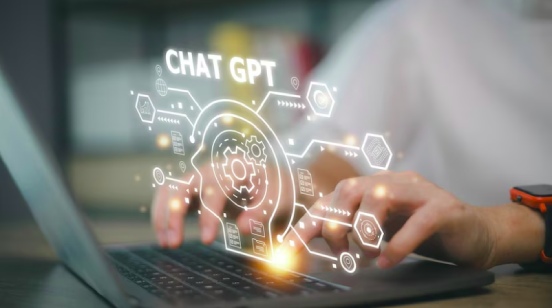-
In the upcoming years, blockchain development services and ChatGPT (a tool for natural language processing) have the potential to completely transform a variety of businesses. It will be possible to build extremely effective and transparent decentralized solutions that can operate autonomously and base decisions on established rules and algorithms by fusing the strength of blockchain technology with ChatGPT's capabilities.
In this blog, we will examine how ChatGPT and blockchain technology may develop and combine soon, highlighting the potential uses and advantages of this union.
ChatGPT and Blockchain Use Cases
Smart Contracts Development
Smart contract development is still a very complex undertaking for developers.
Components of ChatGPT like Codex can translate language descriptions into Solidity code.
Imagine a smart contract assistant that will provide the appropriate smart contract code snippet when a developer types something like, "What's the solidity code to request a flash loan in Ave?"
Testing for Smart Contract Security
Smart contract audits are time-consuming, expensive, and unpleasant processes, but they are nonetheless required.
Most of the auditing process involves running tests, which are frequently not clear to coders of smart contracts. Imagine a specialized ChatGPT for smart contract audits that could conduct a series of tests in a specific smart contract using a language input like "".
NFTs Development
The ability to create a new generation of conversational intelligent non-fungible tokens (NFT) is perhaps one of the most obvious applications of models like ChatGPT.
Imagine a version of your preferred NFT collection where you may inquire about the artist's sources of inspiration or particular aesthetic nuances.
DAO
It is anticipated that in the future, ChatGPT and blockchain technology will combine to significantly contribute to the growth of decentralized autonomous organizations (DAOs).
DAOs, or decentralized autonomous organizations, are governed by smart contracts, which are self-executing contracts in which the terms of the agreement between the buyer and seller are directly encoded into lines of code.
It will be possible to develop DAOs that can function independently and base choices on predetermined rules and algorithms by using ChatGPT to build and administer smart contracts.
The automation of various tasks and processes is one possible use for ChatGPT-powered DAOs.
For instance, by handling routine customer service queries, a chatbot powered by GPT could free up human customer service representatives to concentrate on more complicated problems.
Similar to how ChatGPT can be used to automate the onboarding of new clients, identity verification, and transaction handling, these procedures can be streamlined and made more effective.
Also, Explore | Most Substantial DAO Use Cases for Businesses
Crypto Wallet Development
Crypto wallets can be created and tested using ChatGPT. It can be used, for instance, to create user interfaces that explain wallet features and functionality in natural English.
To make sure wallet software is operating properly, it can also be used to create test cases and test data.
Last but not least, ChatGPT can be employed to produce answers to user questions and support requests, giving users a more efficient and natural way to engage with their wallets.
White Paper Development
Using ChatGPT, white papers can be created by either fine-tuning the model on an existing data set of white papers or by giving it specific cues and instructions to produce text.
To create text that follows a particular format and tone, the model would first be trained on a collection of pertinent data, such as technical specifications and industry terms.
It can also help to ensure that the model generates content that is tailored to those variables by giving details about the white paper's purpose and target audience.
You may also want to read | A Guide to Whitepaper Development for Cryptocurrency Projects
Simulation
Blockchain developers can simulate using ChatGPT in the following ways:
Use ChatGPT to simulate a variety of scenarios on a blockchain network, such as assessing the network's efficiency in different situations or simulating various attacks to see how the network would respond.
They can use ChatGPT to simulate the behavior of different user types on a blockchain network, which will help them better grasp how the network will be used in practical situations.
Developers can use ChatGPT to model market conditions and project the price of the assets to help them decide whether to buy or sell blockchain assets.
Blockchain engineers may use ChatGPT to simulate the economic incentives and disincentives of different network members to better understand how the network will function in terms of tokens and crypto-economics.
You may also like | ChatGPT and Crypto: Fuelling a New Era of Endless Possibilities
DApp Development
ChatGPT is a language model, and only text-based applications can use it. There are several methods for creating a DApp using ChatGPT, as described below:
Creating smart contract codes for different blockchains is one approach.
Automating the process of developing smart contracts, can make it simpler for programmers to launch DApps on the blockchain.
Another method is to create UI/UX content using GPT-3 and then incorporate it into a decentralized program. A dApp may become more interesting and user-friendly as a result.
A dApp's chatbot feature can also be generated using ChatGPT, enabling users to communicate with the decentralized application in their language.
Also, Visit |A Comprehensive List of Top dApp Development Platforms
Conclusion
The main field of ChatGPT's influence on the Blockchain and Web3 sectors is natural language processing. It has the potential to improve user experience and lighten the workload of professionals by fostering more human-like interactions between users and Blockchain/Web3 apps. These technologies will become more engaging as a result of the addition of AI, which will also improve transaction security and effectiveness and spur innovation across a range of industries. For more information on the convergence of blockchain and ChatGPT applications, connect with our skilled blockchain developers.

Our Offices
INDIA
Emaar Digital Greens, Sector 61,
Gurugram, Haryana
122011.
Welldone Tech Park,
Sector 48, Sohna road,
Gurugram, Haryana
122018.















